Peter Paul Rubens
| Sir Peter Paul Rubens | |
|---|---|
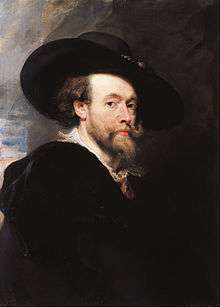 Self-portrait, 1623, Royal Collection | |
| Born |
Peter Paul Rubens 28 June 1577 Siegen, Nassau-Dillenburg (now North Rhine-Westphalia, Germany) |
| Died |
30 May 1640 (aged 62) Antwerp, Spanish Netherlands (now Belgium) |
| Nationality | Flemish |
| Education |
Tobias Verhaecht Adam van Noort Otto van Veen |
| Known for | Painting, Printmaking |
| Movement |
Flemish Baroque Baroque |
| Signature | |
 | |
Sir Peter Paul Rubens (/ˈruːbənz/;[1] Dutch: [ˈrybə(n)s]; 28 June 1577 – 30 May 1640) was a Flemish Baroque painter. A proponent of an extravagant Baroque style that emphasized movement, colour, and sensuality, Rubens is well known for his Counter-Reformation altarpieces, portraits, landscapes, and history paintings of mythological and allegorical subjects.
In addition to running a large studio in Antwerp that produced paintings popular with nobility and art collectors throughout Europe, Rubens was a classically educated humanist scholar and diplomat who was knighted by both Philip IV of Spain and Charles I of England. Rubens was a prolific artist. The catalogue of his works by Michael Jaffé lists 1,403 pieces, excluding numerous copies made in his workshop.[2]
His commissioned works were mostly "history paintings", which included religious and mythological subjects, and hunt scenes. He painted portraits, especially of friends, and self-portraits, and in later life painted several landscapes. Rubens designed tapestries and prints, as well as his own house. He also oversaw the ephemeral decorations of the royal entry into Antwerp by the Cardinal-Infante Ferdinand in 1635.
His drawings are mostly extremely forceful but not overly detailed. He also made great use of oil sketches as preparatory studies. He was one of the last major artists to make consistent use of wooden panels as a support medium, even for very large works, but he used canvas as well, especially when the work needed to be sent a long distance. For altarpieces he sometimes painted on slate to reduce reflection problems.
Biography
Early life

Rubens was born in the city of Siegen to Jan Rubens and Maria Pypelincks. His father, a Calvinist, and mother fled Antwerp for Cologne in 1568, after increased religious turmoil and persecution of Protestants during the rule of the Spanish Netherlands by the Duke of Alba.
Jan Rubens became the legal adviser (and lover) of Anna of Saxony, the second wife of William I of Orange, and settled at her court in Siegen in 1570, fathering her daughter Christine who was born in 1571.[3]
Following Jan Rubens' imprisonment for the affair, Peter Paul Rubens was born in 1577. The family returned to Cologne the next year. In 1589, two years after his father's death, Rubens moved with his mother Maria Pypelincks to Antwerp, where he was raised as a Catholic.
Religion figured prominently in much of his work and Rubens later became one of the leading voices of the Catholic Counter-Reformation style of painting[4] (he had said "My passion comes from the heavens, not from earthly musings").
Apprenticeship

In Antwerp, Rubens received a Renaissance humanist education, studying Latin and classical literature. By fourteen he began his artistic apprenticeship with Tobias Verhaeght. Subsequently, he studied under two of the city's leading painters of the time, the late Mannerist artists Adam van Noort and Otto van Veen.[5] Much of his earliest training involved copying earlier artists' works, such as woodcuts by Hans Holbein the Younger and Marcantonio Raimondi's engravings after Raphael. Rubens completed his education in 1598, at which time he entered the Guild of St. Luke as an independent master.[6]
Italy (1600–1608)
In 1600 Rubens travelled to Italy. He stopped first in Venice, where he saw paintings by Titian, Veronese, and Tintoretto, before settling in Mantua at the court of Duke Vincenzo I Gonzaga. The colouring and compositions of Veronese and Tintoretto had an immediate effect on Rubens's painting, and his later, mature style was profoundly influenced by Titian.[7] With financial support from the Duke, Rubens travelled to Rome by way of Florence in 1601. There, he studied classical Greek and Roman art and copied works of the Italian masters. The Hellenistic sculpture Laocoön and his Sons was especially influential on him, as was the art of Michelangelo, Raphael, and Leonardo da Vinci.[8] He was also influenced by the recent, highly naturalistic paintings by Caravaggio.
.jpg)
Rubens later made a copy of Caravaggio's Entombment of Christ and recommended his patron, the Duke of Mantua, to purchase The Death of the Virgin (Louvre).[9] After his return to Antwerp he was instrumental in the acquisition of The Madonna of the Rosary (Kunsthistorisches Museum, Vienna) for the St. Paul's Church in Antwerp.[10] During this first stay in Rome, Rubens completed his first altarpiece commission, St. Helena with the True Cross for the Roman church of Santa Croce in Gerusalemme.
Rubens travelled to Spain on a diplomatic mission in 1603, delivering gifts from the Gonzagas to the court of Philip III.[11] While there, he studied the extensive collections of Raphael and Titian that had been collected by Philip II.[12] He also painted an equestrian portrait of the Duke of Lerma during his stay (Prado, Madrid) that demonstrates the influence of works like Titian's Charles V at Mühlberg (1548; Prado, Madrid). This journey marked the first of many during his career that combined art and diplomacy.
He returned to Italy in 1604, where he remained for the next four years, first in Mantua and then in Genoa and Rome. In Genoa, Rubens painted numerous portraits, such as the Marchesa Brigida Spinola-Doria (National Gallery of Art, Washington, D.C.), and the portrait of Maria di Antonio Serra Pallavicini, in a style that influenced later paintings by Anthony van Dyck, Joshua Reynolds and Thomas Gainsborough.[13]
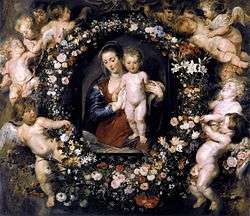
He also began a book illustrating the palaces in the city, which was published in 1622 as Palazzi di Genova. From 1606 to 1608, he was mostly in Rome. During this period Rubens received, with the assistance of Cardinal Jacopo Serra (the brother of Maria Pallavicini), his most important commission to date for the High Altar of the city's most fashionable new church, Santa Maria in Vallicella also known as the Chiesa Nuova.
The subject was to be St. Gregory the Great and important local saints adoring an icon of the Virgin and Child. The first version, a single canvas (now at the Musée des Beaux-Arts, Grenoble), was immediately replaced by a second version on three slate panels that permits the actual miraculous holy image of the "Santa Maria in Vallicella" to be revealed on important feast days by a removable copper cover, also painted by the artist.[14]
Rubens' experiences in Italy continued to influence his work. He continued to write many of his letters and correspondences in Italian, signed his name as "Pietro Paolo Rubens", and spoke longingly of returning to the peninsula—a hope that never materialized.[15]
Antwerp (1609–1621)
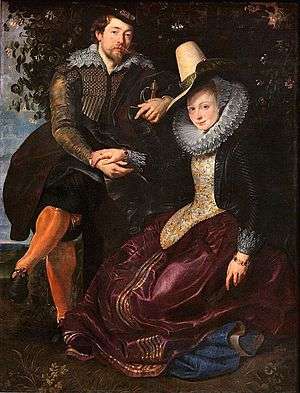
Upon hearing of his mother's illness in 1608, Rubens planned his departure from Italy for Antwerp. However, she died before he arrived home. His return coincided with a period of renewed prosperity in the city with the signing of the Treaty of Antwerp in April 1609, which initiated the Twelve Years' Truce. In September 1609 Rubens was appointed as court painter by Albert VII, Archduke of Austria, and Infanta Isabella Clara Eugenia of Spain, sovereigns of the Low Countries.
He received special permission to base his studio in Antwerp instead of at their court in Brussels, and to also work for other clients. He remained close to the Archduchess Isabella until her death in 1633, and was called upon not only as a painter but also as an ambassador and diplomat. Rubens further cemented his ties to the city when, on 3 October 1609, he married Isabella Brandt, the daughter of a leading Antwerp citizen and humanist, Jan Brandt.
In 1610 Rubens moved into a new house and studio that he designed. Now the Rubenshuis Museum, the Italian-influenced villa in the centre of Antwerp accommodated his workshop, where he and his apprentices made most of the paintings, and his personal art collection and library, both among the most extensive in Antwerp. During this time he built up a studio with numerous students and assistants. His most famous pupil was the young Anthony van Dyck, who soon became the leading Flemish portraitist and collaborated frequently with Rubens. He also often collaborated with the many specialists active in the city, including the animal painter Frans Snyders, who contributed the eagle to Prometheus Bound, and his good friend the flower-painter Jan Brueghel the Elder.
Another house was built by Rubens to the north of Antwerp in the polder village of Doel, "Hooghuis" (1613/1643), perhaps as an investment. The "High House" was built next to the village church.
Altarpieces such as The Raising of the Cross (1610) and The Descent from the Cross (1611–1614) for the Cathedral of Our Lady were particularly important in establishing Rubens as Flanders' leading painter shortly after his return. The Raising of the Cross, for example, demonstrates the artist's synthesis of Tintoretto's Crucifixion for the Scuola Grande di San Rocco in Venice, Michelangelo's dynamic figures, and Rubens' own personal style. This painting has been held as a prime example of Baroque religious art.[16]
Rubens used the production of prints and book title-pages, especially for his friend Balthasar Moretus, the owner of the large Plantin-Moretus publishing house, to extend his fame throughout Europe during this part of his career. With the exception of a couple of brilliant etchings, he only produced drawings for these himself, leaving the printmaking to specialists, such as Lucas Vorsterman, Paulus Pontius and Willem Panneels.[17] He recruited a number of engravers trained by Christoffel Jegher, who he carefully schooled in the more vigorous style he wanted.
He also designed the last significant woodcuts before the 19th century revival in the technique. Rubens established copyright for his prints, most significantly in Holland, where his work was widely copied through prints. In addition he established copyrights for his work in England, France and Spain.[18]
The Marie de' Medici Cycle and diplomatic missions (1621–1630)
.jpg)
In 1621, the Queen Mother of France, Marie de' Medici, commissioned Rubens to paint two large allegorical cycles celebrating her life and the life of her late husband, Henry IV, for the Luxembourg Palace in Paris. The Marie de' Medici cycle (now in the Louvre) was installed in 1625, and although he began work on the second series it was never completed.[19] Marie was exiled from France in 1630 by her son, Louis XIII, and died in 1642 in the same house in Cologne where Rubens had lived as a child.[20]
After the end of the Twelve Years' Truce in 1621, the Spanish Habsburg rulers entrusted Rubens with a number of diplomatic missions.[21] While in Paris in 1622 to discuss the Marie de' Medici cycle, Rubens engaged in clandestine information gathering activities, which at the time was an important task of diplomats. He relied on his friendship with Nicolas-Claude Fabri de Peiresc to get information on political developments in France.[22] Between 1627 and 1630, Rubens' diplomatic career was particularly active, and he moved between the courts of Spain and England in an attempt to bring peace between the Spanish Netherlands and the United Provinces. He also made several trips to the northern Netherlands as both an artist and a diplomat.
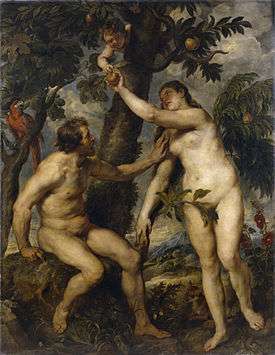
At the courts he sometimes encountered the attitude that courtiers should not use their hands in any art or trade, but he was also received as a gentleman by many. Rubens was raised by Philip IV of Spain to the nobility in 1624 and knighted by Charles I of England in 1630. Philip IV confirmed Rubens' status as a knight a few months later.[23] Rubens was awarded an honorary Master of Arts degree from Cambridge University in 1629.[24]
Rubens was in Madrid for eight months in 1628–1629. In addition to diplomatic negotiations, he executed several important works for Philip IV and private patrons. He also began a renewed study of Titian's paintings, copying numerous works including the Madrid Fall of Man (1628–29).[25] During this stay, he befriended the court painter Diego Velázquez and the two planned to travel to Italy together the following year. Rubens, however, returned to Antwerp and Velázquez made the journey without him.[26]
His stay in Antwerp was brief, and he soon travelled on to London where he remained until April 1630. An important work from this period is the Allegory of Peace and War (1629; National Gallery, London).[27] It illustrates the artist's lively concern for peace, and was given to Charles I as a gift.
While Rubens' international reputation with collectors and nobility abroad continued to grow during this decade, he and his workshop also continued to paint monumental paintings for local patrons in Antwerp. The Assumption of the Virgin Mary (1625–6) for the Cathedral of Antwerp is one prominent example.
Last decade (1630–1640)
Rubens's last decade was spent in and around Antwerp. Major works for foreign patrons still occupied him, such as the ceiling paintings for the Banqueting House at Inigo Jones's Palace of Whitehall, but he also explored more personal artistic directions.
In 1630, four years after the death of his first wife Isabella, the 53-year-old painter married his first wife's niece, the 16-year-old Hélène Fourment. Hélène inspired the voluptuous figures in many of his paintings from the 1630s, including The Feast of Venus (Kunsthistorisches Museum, Vienna), The Three Graces and The Judgment of Paris (both Prado, Madrid). In the latter painting, which was made for the Spanish court, the artist's young wife was recognized by viewers in the figure of Venus. In an intimate portrait of her, Hélène Fourment in a Fur Wrap, also known as Het Pelsken, Rubens' wife is even partially modelled after classical sculptures of the Venus Pudica, such as the Medici Venus.
In 1635, Rubens bought an estate outside Antwerp, the Steen, where he spent much of his time. Landscapes, such as his Château de Steen with Hunter (National Gallery, London) and Farmers Returning from the Fields (Pitti Gallery, Florence), reflect the more personal nature of many of his later works. He also drew upon the Netherlandish traditions of Pieter Bruegel the Elder for inspiration in later works like Flemish Kermis (c. 1630; Louvre, Paris).
Rubens died from heart failure, which was a result of his chronic gout on 30 May 1640. He was interred in Saint Jacob's church, Antwerp. The artist had eight children, three with Isabella and five with Hélène; his youngest child was born eight months after his death.
Art
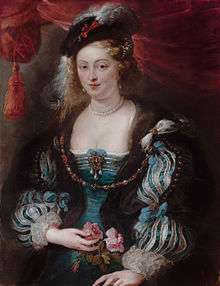
His nudes of various biblical and mythological women are especially well-known. Painted in the Baroque tradition of depicting women as soft-bodied, passive, and highly sexualized beings, his nudes emphasize the concepts of fertility, desire, physical beauty, temptation, and virtue. Skillfully rendered, these paintings of nude women were undoubtedly created to appeal to his largely male audience of patrons.[28] Additionally, Rubens was quite fond of painting full-figured women, giving rise to terms like 'Rubensian' or 'Rubenesque' (sometimes 'Rubensesque'). And while the male gaze features heavily in Rubens's paintings of females generally, he brings multi-layered allegory and symbolism to his portraits.[29] His large-scale cycle representing Marie de Medicis focuses on several classic female archetypes like the virgin, consort, wife, widow, and diplomatic regent.[30] The inclusion of this iconography in his female portraits, along with his art depicting noblewomen of the day, serve to elevate his female portrait sitters to the status and importance of his male portrait sitters.[31]
Rubens's depiction of males is equally stylized, replete with meaning, and quite the opposite of his female subjects. His male nudes represent highly athletic and large mythical or biblical men. Unlike his female nudes, most of his male nudes are depicted partially nude, with sashes, armor, or shadows shielding them from being completely unclothed. These men are twisting, reaching, bending, and grasping: all of which portrays his male subjects engaged in a great deal of physical, sometimes aggressive, action. The concepts Rubens artistically represents illustrate the male as powerful, capable, forceful and compelling. The allegorical and symbolic subjects he painted reference the classic masculine tropes of male dominance, social superiority, war, and civil authority.[32] Male archetypes readily found in Rubens's paintings include the hero, husband, father, civic leader, king, and the battle weary.
Rubens was a great admirer of Leonardo da Vinci's work. Using an engraving done 50 years after Leonardo started his project on the Battle of Anghiari, Rubens did a masterly drawing of the Battle which is now in the Louvre in Paris. "The idea that an ancient copy of a lost artwork can be as important as the original is familiar to scholars," says Salvatore Settis, archaeologist and art historian.
 Peter Paul Rubens works at the Royal Museums of Fine Arts, Antwerp, Belgium
Peter Paul Rubens works at the Royal Museums of Fine Arts, Antwerp, Belgium- Peter Paul Rubens work at the Louvre
- Peter Paul Rubens works at the Victor Balaguer Museum
Workshop
Paintings from Rubens' workshop can be divided into three categories: those he painted by himself, those he painted in part (mainly hands and faces), and those he only supervised as other painters produced them from his drawings or oil sketches. He had, as was usual at the time, a large workshop with many apprentices and students, some of whom, such as Anthony van Dyck, became famous in their own right. He also often sub-contracted elements such as animals or still-life in large compositions to specialists such as Frans Snyders, or other artists such as Jacob Jordaens.
Selected works
- Early works
- Portrait of a Young Woman with a Rosary, Thyssen-Bornemisza Museum, Madrid c. 1609
 Venus at the Mirror, 1615
Venus at the Mirror, 1615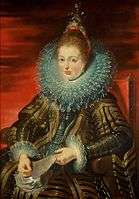 Infanta Isabella Clara Eugenia (1566–1633), 1615. Kunsthistorisches Museum, Vienna.
Infanta Isabella Clara Eugenia (1566–1633), 1615. Kunsthistorisches Museum, Vienna. Virgin in Adoration before the Christ Child, c. 1615
Virgin in Adoration before the Christ Child, c. 1615 Diana Returning from Hunt, 1615 Gemäldegalerie Alte Meister
Diana Returning from Hunt, 1615 Gemäldegalerie Alte Meister Tiger Hunt, 1617-1618
Tiger Hunt, 1617-1618 Hippopotamus Hunt (1616). Rubens is known for the frenetic energy and lusty ebullience of his paintings.
Hippopotamus Hunt (1616). Rubens is known for the frenetic energy and lusty ebullience of his paintings.
- Historical portraits
 Portrait of Marchesa Brigida Spinola-Doria, 1606
Portrait of Marchesa Brigida Spinola-Doria, 1606.jpg) Portrait of King Philip IV of Spain, c. 1628/1629
Portrait of King Philip IV of Spain, c. 1628/1629 Portrait of Elisabeth of France. 1628, Kunsthistorisches Museum. Vienna
Portrait of Elisabeth of France. 1628, Kunsthistorisches Museum. Vienna Portrait of Ambrogio Spinola, c. 1627 National Gallery in Prague
Portrait of Ambrogio Spinola, c. 1627 National Gallery in Prague
- Landscapes
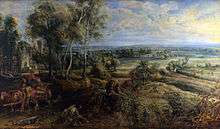
 Miracle of Saint Hubert, painted together with Jan Bruegel, 1617
Miracle of Saint Hubert, painted together with Jan Bruegel, 1617 Landscape with the Ruins of Mount Palatine in Rome, 1615
Landscape with the Ruins of Mount Palatine in Rome, 1615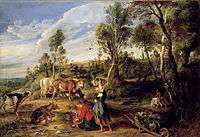 Landscape with Milkmaids and Cattle, 1618
Landscape with Milkmaids and Cattle, 1618
- Mythological
_002.jpg) Nymphs filling the horn of plenty, 1615, together with Jan Brueghel the Elder
Nymphs filling the horn of plenty, 1615, together with Jan Brueghel the Elder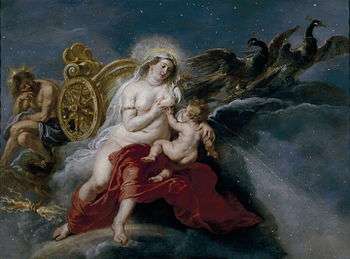 The Birth of the Milky Way, 1636-1637, Madrid, Museo del Prado
The Birth of the Milky Way, 1636-1637, Madrid, Museo del Prado Venus and Adonis
Venus and Adonis Jupiter and Callisto, 1613, Museumslandschaft of Hesse in Kassel
Jupiter and Callisto, 1613, Museumslandschaft of Hesse in Kassel
- Marie de' Medici cycle (1622-1625)
 Series on Maria de' Medici; The Flight from Blois
Series on Maria de' Medici; The Flight from Blois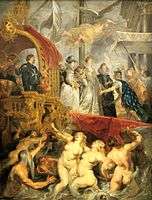 Maria de' Medici's arrival in Marseille
Maria de' Medici's arrival in Marseille The Education of the Princess, from the Marie de' Medici cycle
The Education of the Princess, from the Marie de' Medici cycle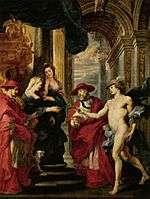 The Negotiations at Angoulême
The Negotiations at Angoulême
- Religious paintings
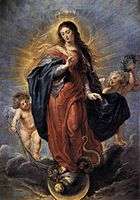 The Virgin of the Immaculate Conception, 1626-1628. Madrid, Museo del Prado.
The Virgin of the Immaculate Conception, 1626-1628. Madrid, Museo del Prado.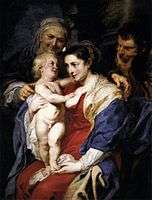 The Holy Family 1630, Prado
The Holy Family 1630, Prado The feast of Herodes
The feast of Herodes Samson and Delilah, 1609–1610
Samson and Delilah, 1609–1610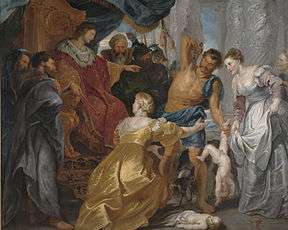 King Solomon, 1617
King Solomon, 1617 The Fall of the Damned, ca. 1620
The Fall of the Damned, ca. 1620
- Nude
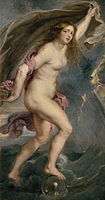 Fortuna, 1638
Fortuna, 1638 Susanna and the Elders, 1608
Susanna and the Elders, 1608 The Triumph of the Virtue 1608
The Triumph of the Virtue 1608 Hygeia, 1615. Prague, Lobkowicz Palace.
Hygeia, 1615. Prague, Lobkowicz Palace.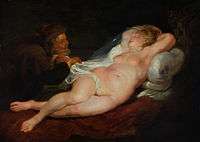 Ermit and sleeping Angelica, 1628
Ermit and sleeping Angelica, 1628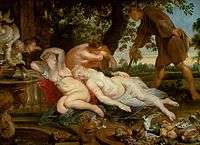 Cimone and Efigenia, 1615
Cimone and Efigenia, 1615 Venus, Cupid, Baccchus and Ceres, 1612
Venus, Cupid, Baccchus and Ceres, 1612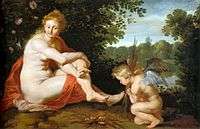 Amor and Venus 1614
Amor and Venus 1614 The Three Graces, 1635, Prado
The Three Graces, 1635, Prado
- Helena Fourment and related pictures
 Rubens with Hélène Fourment and their son Peter Paul, 1639, now in the Metropolitan Museum of Art
Rubens with Hélène Fourment and their son Peter Paul, 1639, now in the Metropolitan Museum of Art Helena Fourment in wedding dress, detalj, the artist's second wife.ca. 1630, now in the Alte Pinakothek
Helena Fourment in wedding dress, detalj, the artist's second wife.ca. 1630, now in the Alte Pinakothek Helena Fourment with a Carriage, 1639 Louvre.
Helena Fourment with a Carriage, 1639 Louvre. Helene Fourment with Rubens and their child, c. 1630
Helene Fourment with Rubens and their child, c. 1630- Venus and Cupid, 1640
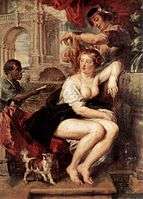 Bathsheba at the Fountain, 1635
Bathsheba at the Fountain, 1635 Venus, Mars and Cupid
Venus, Mars and Cupid Pastoral Scene, 1636
Pastoral Scene, 1636 Portrait of Hélène Fourment (Het Pelsken), c. 1638 Kunsthistorisches Museum, Vienna
Portrait of Hélène Fourment (Het Pelsken), c. 1638 Kunsthistorisches Museum, Vienna
- Drawings
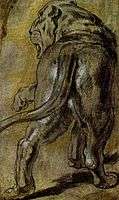 Lion, c.1614-1615. Black and yellow chalk, grey wash, heightened with white
Lion, c.1614-1615. Black and yellow chalk, grey wash, heightened with white Peter Paul Rubens' son, Nikolas, 1621
Peter Paul Rubens' son, Nikolas, 1621 Isabella Brandt, (first wife of Peter Paul Rubens), 1621
Isabella Brandt, (first wife of Peter Paul Rubens), 1621 Peter Paul Rubens (Possible self-portrait), c.1620s
Peter Paul Rubens (Possible self-portrait), c.1620s Young Woman with Folded Hands, circa 1629-1630
Young Woman with Folded Hands, circa 1629-1630
Lost works
.jpg)
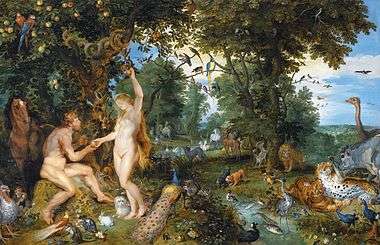
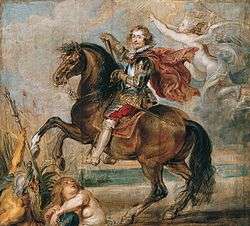
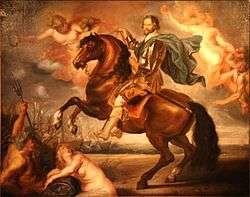
Works Missing by Rubens are:
- The painting The Crucifixion, painted for the Church of Santa Croce in Gerusalemme, Rome, was imported to England in 1811. It was auctioned in 1812 and again in 1820 and 1821 but was lost at sea sometime after 1821.[33]
- Equestrian Portrait of the Archduke Albert,
- Susannah and the Elders now known only from engraving from 1620 by Lucas Vostermanand;
- Satyr, Nymph, Putti and Leopards now known only from engraving and
- Judith Beheading Holofernes c. 1609 known only though the 1610 engraving by Cornelis Galle the Elder.
- Works destroyed in the bombardment of Brussels are the Madonna of the Rosary painted for the Royal Chapel of the Dominican Church, Brussels, Virgin Adorned with Flowers by Saint Anne, 1610 painted for the Church of the Carmelite Friars, Saint Job Triptych, 1613, painted for Saint Nicholas Church, Brussels, Cambyses Appointing Otanes Judge Judgment of Solomon the Last Judgment that were decorations for the Magistrates' Hall, Brussels.
- In the Coudenberg Palace fire there were several works by Rubens destroyed, like Nativity (1731), Adoration of the Magi and Pentecost.[34]
- The paintings Neptune and Amphitrite, Vision of Saint Hubert and Diana and Nymphs Surprised by Satyrs was destroyed in the Friedrichshain flak tower fire in 1945.[35]
- The painting The Abduction of Proserpine was destroyed in the fire at Blenheim Palace, Oxfordshire, 5 February 1861.[36]
- The painting Crucifixion with Mary, St. John, Magdalen, 1643 was destroyed in the English Civil War: English Parliamentarians in the Queen's Chapel, Somerset House, London, 1643[37]
- The painting Equestrian Portrait of Philip IV of Spain was destroyed in the fire at Royal Alcázar of Madrid fire in 1734. A copy is in the Uffizi Gallery.
- The Continence of Scipio was destroyed in a Fire in the Western Exchange, Old Bond Street, London, March 1836[38]
- The painting The Lion Hunt was removed by Napoleon's agents from Schloss Schleissheim, near Munich, 1800 and was destroyed later in a fire at the Musée des Beaux-Arts de Bordeaux[39]
- An alleged Reuben painting Portrait of a Girl reported to have been in the collection of Alexander Dumas; reported lost in a fire.[40]
- The painting Equestrian Portrait of the Duke of Buckingham, later owned by the Earl of Jersey at Osterley Park, was destroyed in a fire in 1949[41] and
- Portrait of Philip IV of Spain from 1628 was destroyed in the Incendiary attack at the Kunsthaus, Zurich, in 1985.[42]
Art market
At a Sotheby's auction on 10 July 2002, Rubens's painting Massacre of the Innocents, rediscovered not long before, sold for £49.5 million (US$76.2 million) to Lord Thomson. At the end of 2013 this remained the record auction price for an Old Master painting. At a Christie's auction in 2012, Portrait of a Commander sold for £9.1 million (US$13.5 million) despite a dispute over the authenticity so that Sotheby's refused to auction it as a Rubens.[43]
Selected exhibitions
1936 Rubens and His Times, Paris.
1997 The Century of Rubens in French Collections, Paris.
2004 Rubens, Palais de Beaux-Arts, Lille.
2005 Peter Paul Rubens: The Drawings, Metropolitan Museum of Art, New York.
2015 Rubens and His Legacy, The Royal Academy, London.
In popular culture
In Ouida's novel A Dog of Flanders the main characters Nello and Patrasche wish to see both Rubens' "The Elevation of the Cross" and "The Descent from the Cross" for once in their life. It serves as the climax of the story, as they both sneak inside the Antwerp Cathedral on a freezing Christmas Eve to witness the beauty of the painting. The next day they are found frozen to death in front of the triptych.[44]
See also
Notes
- ↑ "Rubens". Random House Webster's Unabridged Dictionary.
- ↑ Nico Van Hout, 1979
- ↑ H. C. Erik Midelfort, "Mad Princes of Renaissance Germany", page 58, University of Virginia Press, 22 January 1996. Retrieved 2 February 2013.
- ↑ Belkin (1998): 11–18.
- ↑ Held (1983): 14–35.
- ↑ Belkin (1998): 22–38.
- ↑ Belkin (1998): 42; 57.
- ↑ Belkin (1998): 52–57
- ↑ Belkin (1998): 59.
- ↑ Sirjacobs, Raymond. Antwerpen Sint-Pauluskerk: Rubens En De Mysteries Van De Rozenkrans = Rubens Et Les Mystères Du Rosaire = Rubens and the Mysteries of the Rosary, Antwerpen: Sint-Paulusvrienden, 2004
- ↑ Rosen, Mark (2008). "The Medici Grand Duchy and Rubens' First Trip to Spain". Oud Holland (Vol. 121, No. 2/3): 147–152.
- ↑ Belkin (1998): 71–73
- ↑ Belkin (1998): 75.
- ↑ Jaffé (1977): 85–99; Belting (1994): 484–90, 554–56.
- ↑ Belkin (1998): 95.
- ↑ Martin (1977): 109.
- ↑ Pauw-De Veen (1977): 243–251.
- ↑ A Hyatt Mayor, Prints and People, Metropolitan Museum of Art/Princeton, 1971, no.427–32, ISBN 0-691-00326-2
- ↑ Belkin (1998): 175; 192; Held (1975): 218–233, esp. pp. 222–225.
- ↑ Belkin (1998): 173–175.
- ↑ Belkin (1998): 199–228.
- ↑ Auwers: p. 25.
- ↑ Auwers: p. 32.
- ↑ Belkin (1998): 339–340
- ↑ Belkin (1998): 210–218.
- ↑ Belkin (1998): 217–218.
- ↑ "Minerva protects Pax from Mars ('Peace and War')". The National Gallery. Retrieved 15 October 2010.
- ↑ "Review on JSTOR". JSTOR 431556.
- ↑ "Gender in Art – Dictionary definition of Gender in Art | Encyclopedia.com: FREE online dictionary". www.encyclopedia.com. Retrieved 2016-03-05.
- ↑ "Rubens's France: Gender and Personification in the Marie de Médicis Cycle on JSTOR". JSTOR 3177384.
- ↑ "Rubens's France: Gender and Personification in the Marie de Médicis Cycle on JSTOR". JSTOR 3177384.
- ↑ "Gender in Art – Dictionary definition of Gender in Art | Encyclopedia.com: FREE online dictionary". www.encyclopedia.com. Retrieved 2016-03-05.
- ↑ Smith, John (1830), A Catalogue Raisonné of the Works of the Most Eminent Dutch, Flemish, and French Painters: Peter Paul Rubens, Smith
- ↑ Joost vander Auwera (2007), Rubens, l'atelier du génie, Lannoo Uitgeverij, p. 14, ISBN 978-90-209-7242-9
- ↑ John Smith, A catalogue raisonne of the works of the most eminent (...)(1830), p. 153. Retrieved 8 June 2014.
- ↑ The Annual Register, Or, A View of the History, Politics, and Literature for the Year ..., J. Dodsley, 1862, p. 18
- ↑ Albert J. Loomie, "A Lost Crucifixion by Rubens," The Burlington Magazine Vol. 138, No. 1124 (Nov. 1996). Retrieved 8 June 2014.
- ↑ W. Pickering, The Gentleman's Magazine vol. 5 (1836), p.590. Retrieved 7 June 2014.
- ↑ Barnes, An examination of Hunting Scenes by Peter Paul Rubens(2009), p.34. Retrieved 7 June 2014.
- ↑ San Francisco Call, Volume 103, Number 57, 26 January 1908
- ↑ Sutton, Peter C. (2004), Drawn by the Brush: Oil Sketches by Peter Paul Rubens, Yale University Press, p. 144, ISBN 978-0-300-10626-8
- ↑ Goss, Steven (2001), "A Partial Guide to the Tools of Art Vandalism", Cabinet Magazine (3)
- ↑ Art historians cast doubt over Earl Spencer's £9m Rubens, The Independent, 11 July 2010
- ↑ http://www.argosarts.org/work.jsp?workid=42b99ac823034ab7abac8b689b417e3d
Sources
- Auwers, Michael, Pieter Paul Rubens als diplomatiek debutant. Het verhaal van een ambitieus politiek agent in de vroege zeventiende eeuw, in: Tijdschrift voor Geschiedenis – 123e jaargang, nummer 1, p. 20–33 (Dutch)
- Belkin, Kristin Lohse (1998). Rubens. Phaidon Press. ISBN 0-7148-3412-2.
- Belting, Hans (1994). Likeness and Presence: A History of the Image before the Era of Art. University of Chicago Press. ISBN 0-226-04215-4.
- Held, Julius S. (1975) "On the Date and Function of Some Allegorical Sketches by Rubens." In: Journal of the Warburg and Courtauld Institutes. Vol. 38: 218–233.
- Held, Julius S. (1983) "Thoughts on Rubens' Beginnings." In: Ringling Museum of Art Journal: 14–35. ISBN 0-916758-12-5.
- Jaffé, Michael (1977). Rubens and Italy. Cornell University Press. ISBN 0-8014-1064-9.
- Martin, John Rupert (1977). Baroque. HarperCollins. ISBN 0-06-430077-3.
- Mayor, A. Hyatt (1971). Prints and People. Metropolitan Museum of Art/Princeton. ISBN 0-691-00326-2.
- Pauw-De Veen, Lydia de. "Rubens and the graphic arts." In: Connoisseur CXCV/786 (Aug 1977): 243–251.
Further reading
- Alpers, Svetlana. The Making of Rubens. New Haven 1995.
- Heinen, Ulrich, "Rubens zwischen Predigt und Kunst." Weimar 1996.
- Baumstark , Reinhold (1985). Peter Paul Rubens: the Decius Mus cycle. New York: The Metropolitan Museum of Art. ISBN 0870993941.
- Büttner, Nils, Herr P. P. Rubens. Göttingen 2006.
- Corpus Rubenianum Ludwig Burchard. An Illustrated Catalogue Raisonne of the Work of Peter Paul Rubens Based on the Material Assembled by the Late Dr. Ludwig Burchard in Twenty-Seven Parts, Edited by the Nationaal Centrum Voor de Plastische Kunsten Van de XVI en de XVII Eeuw.
- Lamster, Mark. Master of Shadows, The Secret Diplomatic Career of Peter Paul Rubens New York, Doubleday, 2009.
- Lilar, Suzanne, Le Couple (1963), Paris, Grasset; Reedited 1970, Bernard Grasset Coll. Diamant, 1972, Livre de Poche; 1982, Brussels, Les Éperonniers, ISBN 2-87132-193-0; Translated as Aspects of Love in Western Society in 1965, by and with a foreword by Jonathan Griffin, New York, McGraw-Hill, LC 65-19851.
- Sauerlander, Willibald. The Catholic Rubens: Saints and Martyrs (Getty Research Institute; 2014); 311 pages; looks at his altarpieces in the context of the Counter-Reformation.
- Schrader, Stephanie, Looking East: Ruben's Encounter with Asia, Getty Publications, Los Angeles, 2013. ISBN 978-1-60606-131-2
- Vlieghe, Hans, Flemish Art and Architecture 1585–1700, Yale University Press, Pelican History of Art, New Haven and London, 1998. ISBN 0-300-07038-1
External links
| Wikimedia Commons has media related to Peter Paul Rubens. |
- Rubens' palette and painting materials, with bibliography
- The Guardian: Rubens
- Rubenshuis in Antwerp, (Belgium) is the former house of Rubens, now converted into a museum.
- 290 of images by the artist, and more.
- The Correspondence of Peter Paul Rubens in EMLO
- Mark Lamster (10 October 2009). "The Art of Diplomacy – Review of "Master of Shadows: The Secret Diplomatic Career of the Painter Peter Paul Rubens"". The Wall Street Journal.
- RubensOnline: a database with every Rubens painting in Flemish public collections and historical places [Dutch]
- Madonna at the Palace Museum in Wilanów

